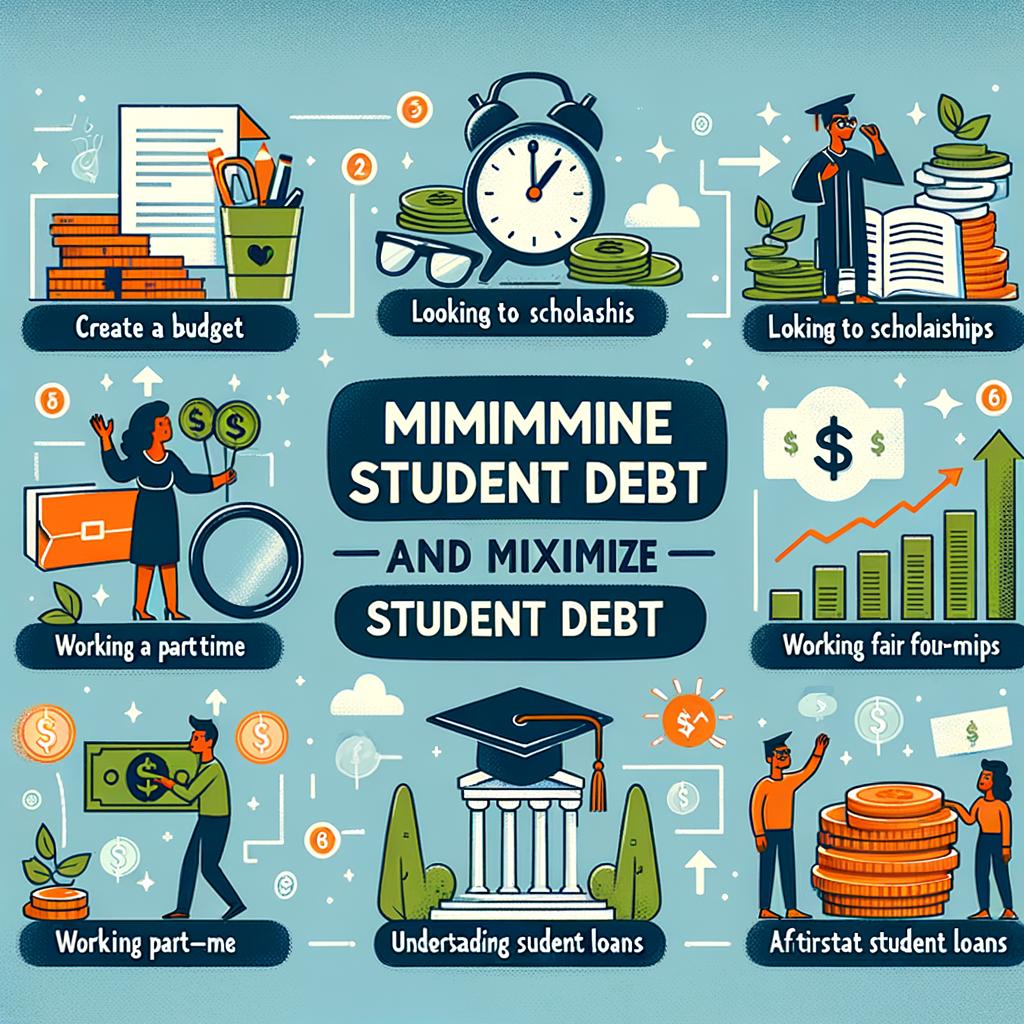Navigating the labyrinth of financial aid and tuition can feel like an odyssey in its own right—a quest fraught with elusive acronyms and daunting figures. The mere mention of FAFSA, grants, loans, and scholarship opportunities can send both students and parents into a spiral of confusion. Yet, understanding this complex tapestry is essential in unlocking the gates to educational institutions without being ensnared by debt.
In this article, we delve into the intricate world of financial aid and tuition, unpacking everything from need-based aid to merit scholarships, and decoding the true cost of higher education. Whether you are a high school senior with Ivy League dreams, a returning student aiming to improve career prospects, or a parent contemplating how to finance your child’s education without breaking the bank, this guide aims to light your path. Join us as we demystify the numbers and strategies that could make higher education both accessible and affordable.
Table of Contents
- Understanding the Landscape of Financial Aid: Types and Sources
- Navigating the Application Process for Scholarships and Grants
- Strategies for Minimizing Student Debt and Maximizing Aid Opportunities
- The Future of Tuition: Trends and Predictions in Education Financing
- Final Thoughts

Understanding the Landscape of Financial Aid: Types and Sources
Embarking on an educational journey can be financially daunting, but understanding the myriad of financial aid options available can pave the way to a smoother academic journey. Financial aid varies widely in types and sources, each uniquely designed to cushion the financial burden on students. Here’s a deep dive into these variants and where they stem at their roots.
Grants and Scholarships are gifts that don’t require repayment, making them most desirable. Grants are typically need-based and funded by federal or state governments, while scholarships are merit-based or for specific groups, funded by private organizations or the educational institutions themselves.
Loans, on the other hand, are borrowed money that must be repaid with interest. Federal student loans usually offer lower interest rates and more flexible repayment options in comparison to private student loans, which are offered by banks, credit unions, and other financial institutions.
Work-study programs allow students to work part-time, often on-campus, to earn money for their education without having to commute far. This not only offsets education costs but also provides valuable work experience.
To better understand the plethora of options, let’s break down a chart detailing some common sources of these financial aids:
| Type of Aid | Source | Typical Requirements |
|---|---|---|
| Federal Grants | Federal Government | Financial Need |
| Scholarships | Private Organizations | Merit or specific criteria |
| State Grants | State Government | Residency, Financial Need |
| Private Student Loans | Banks, Credit Unions | Credit Score, Income |
| Federal Government | Financial Need, Academic performance |
In addition to understanding types and sources, it’s crucial for students to explore and apply for financial aid. Applications for federal aid open every October for the following academic year and require the completion of the Free Application for Federal Student Aid (FAFsa). Scholarships, however, may have varying deadlines and application charge.
While navigating the financial aid landscape seems overwhelming, early preparation and research can significantly demystify the process. Engage with financial aid counselors at prospective schools, visit their websites, and even connect with current students to understand application nuances.
Remember, the ultimate goal of financial aid is to support your educational aspirations. With the right information and proactive strategies, securing financial aid that aligns with your academic and career goals becomes considerably more attainable.

Navigating the Application Process for Scholarships and Grants
Finding and acquiring financial aid such as scholarships and grants can seem like navigating a labyrinth. But don’t fret; adopting a strategic approach can significantly increase your chances of success. Here’s how you can master the art of the application process for these invaluable educational resources.
Start Early and Stay Organized
Preparation is key. Begin by marking deadlines on your calendar and setting reminders for yourself. Gather all the necessary documents you might need, like your transcripts, recommendation letters, and your family’s financial information. Organizing these materials early on will save you from last-minute scrambles and will ensure that you apply on time.
Research Thoroughly
Dive deep into research. Many scholarships and grants go unclaimed simply because students aren’t aware they exist. Check out local businesses, community organizations, and federal and state government websites. Remember, the more specific the scholarship, the less competition you might face, and the greater your chances of winning.
- Research locational scholarships specific to your region
- Look for awards based on unique skills or interests
- Explore options specifically for underrepresented or minority groups
Understand Each Requirement
Each scholarship or grant you apply to will have its own set of requirements—some might need an essay, others a portfolio. Make sure you understand exactly what is expected for each application, and tailor your submission to meet these requirements perfectly.
| Document | Purpose | Tips |
|---|---|---|
| Essay | To showcase your writing skills and alignment with scholarship goals | Be genuine and concise; let your personality shine through |
| Recommendation Letter | Provides third-party validation of your achievements and character | Choose recommenders who truly know you and can speak to your strengths |
| Financial Info | Used to assess need-based applications | Ensure all financial documentation is accurate and up-to-date |
Emphasize Your Strengths
In your applications, highlight what makes you a unique and deserving candidate. Whether it’s your academic achievements, community service, or a particular talent, make sure these highlights align with the scholarship or grant’s objectives. Crafting a narrative that connects your personal story to the mission of the award can set you apart from other applicants.
Edit and Review
Your application should be flawless. Any spelling or grammatical errors can detract from the professionalism of your submission. Have a trusted teacher or mentor review your application materials before submission. A second set of eyes can catch errors you might have missed and provide useful feedback.
Follow Up
Once you’ve submitted your application, it doesn’t hurt to follow up, particularly if the organization allows it. A polite email inquiring about the status of your application keeps you on the radar and demonstrates your genuine interest in the opportunity.
Remember, persistence is key. Applying for scholarships and grants can be a numbers game—the more you apply to, the better your chances of winning. So keep at it, and don’t get discouraged by rejections. Every application is a step closer to achieving your educational and personal goals.

Strategies for Minimizing Student Debt and Maximizing Aid Opportunities
Embarking on your college journey can be as financially demanding as it is exciting. However, with thoughtful planning and strategic actions, it’s possible to reduce the burden of student loans while securing the maximum financial aid available. Here’s how:
1. Start Early with Scholarship Searches
The scholarship arena is vast and varied, and starting your search early heightens your chances of securing non-repayable funding. Utilize platforms like Fastweb, Scholarships.com, and the College Board’s Scholarship Search to discover opportunities that align with your academic achievements, extracurricular activities, and unique personal background.
2. Apply for Federal and State Grants
Don’t overlook grants, which, like scholarships, do not require repayment. Fill out the Free Application for Federal Student Aid (FAFSA) as soon as it’s available to check your eligibility for federal grants such as the Pell Grant or institutional aid. Additionally, explore state-specific grants, which can offer significant aid based on residency, merit, or need.
3. Understand Each College’s Financial Aid Policies
Each institution has its own set of rules regarding financial aid. Investigate whether your target schools use the CSS Profile along with the FAFSA for determining financial aid. This can influence the amount of aid you might receive and can help in making informed choices about where to attend.
4. Consider Work-Study Programs
Work-study programs can be an excellent way to fund your education while gaining professional experience. These programs typically allow you to work part-time while studying. Although earnings are typically modest, they do not count against you on next year’s FAFSA.
5. Maintain your Eligibility for Aid
Your financial aid is not just a one-time setup; it needs to be maintained. Ensure you meet the Satisfactory Academic Progress (SAP) standards that govern your eligibility to continue receiving aid. This usually includes maintaining a specified GPA and completing a certain percentage of attempted credits.
6. Consider Affordable Institutions
Community colleges and public universities often offer quality education at a more affordable cost. Completing your general education courses at a community college and then transferring to a larger university can significantly cut down your educational expenses.
7. Strategic Course Planning
Being strategic with your course load can reduce costs significantly. Enrolling in Advanced Placement or dual credit courses during high school can decrease the number of credits you need to graduate. Additionally, summer courses often have lower tuition rates and can help you graduate earlier, reducing your overall educational expenses.
Financial Comparison Table:
| Strategy | Potential Savings | Effort Required |
|---|---|---|
| Scholarships | High | High |
| Grants | Medium | Medium |
| Work-study | Low to Medium | Medium |
| Community College First 2 Years | High | Low |
| AP/Dual Credit | Medium to High | High |
Investing time in understanding and leveraging these strategies can dramatically reduce your educational expenses and minimize the debt burden, setting you up not only for academic success but also for financial stability post-graduation.

The Future of Tuition: Trends and Predictions in Education Financing
In the evolving landscape of higher education, the financial mechanisms that facilitate student enrollment are shifting dramatically. With rising tuition costs, the traditional model of paying for college is becoming less feasible for the majority, prompting a reevaluation of funding approaches among institutions and policymakers alike.
Among the predominant trends is an increasing reliance on income-share agreements (ISAs). These agreements represent a revolutionary shift where payments are proportionate to a graduate’s post-college income, providing a significant relief to students concerned about financial burdens post-graduation.
Technology is also playing a pivotal role in transforming education financing. Platforms leveraging blockchain technology are on the rise, offering new methods for securing and distributing financial aid transparently and efficiently. This promises a decrease in administrative costs and an increase in access to funds for students.
Digital currencies are beginning to permeate the tuition payment sphere as well. Several universities across the globe now accept Bitcoin for tuition payments, reflecting a broader acceptance of cryptocurrency and its potential to make financial transactions easier for international students.
In response to student demand for more flexible payment options, some institutions are adopting a more modular approach to education. This allows students to pay for smaller, more digestible segments of their education, reducing upfront costs and aligning educational expenses more closely with individual pacing and needs.
| Year | |
|---|---|
| 2021 | Traditional Semester Payments |
| 2023 | Modular Payments |
| 2025 (Predicted) | Income-Share Agreements |
Futuristic as it may seem, there’s also enthusiastic discourse around the potential of AI and machine learning. These technologies could one day help tailor individual financing options based on predictive analytics, assessing a student’s future earning potential and risk.
However, amidst these innovative trends, there are growing concerns about data privacy and the ethical use of personal financial information. As solutions become more personalized, the need for robust privacy safeguards becomes crucial.
Yet, despite promising advancements, the higher education sector continues to grapple with equity and accessibility. High-tech solutions might not be universally accessible or might favor certain demographics, leading to a wider gap in education equality. As such, continuous evaluation and adjustment of these financing innovations will be necessary to ensure they benefit a broad range of students.
the path forward for education financing is multifaceted and dynamic. As we venture into a future where education is increasingly seen as an investment with variable returns, the mechanisms of financial aid and tuition payment are adapting, promising more individualized and sustainable approaches for students worldwide.
Final Thoughts
As the curtain falls on our exploration of financial aid and tuition, we are reminded that the journey through the complexities of funding an education is both challenging and enrichent. Though the landscape may seem daunting with its myriad terms and conditions, remember that each step taken is a stride towards empowerment through learning. Whether you’re a student just embarking on this quest, a parent supporting from the sidelines, or an adult seeking to expand your horizons, the paths to managing tuition are as diverse as the learners who walk them. Keep the knowledge gleaned from today close at hand, and let it light your way. Remember, every educational journey is unique, and though the financial pathways may diverge, the destination of enriched knowledge remains gloriously the same.
